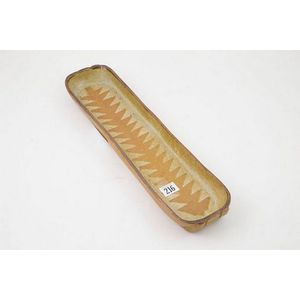Ivory Buddha Head Carving and Comb
A vintage ivory head of Buddha carving and a small comb, utilising the natural curvature of the tusk, carved and pierced in low relief with the calm visage of the Buddha, engraved characters underside to cartouche, and; a small comb with a pierced frame, height 11 cm, (buddah head) length 9.5 cm, (comb)
You must be a subscriber, and be logged in to view price and dealer details.
Subscribe Now to view actual auction price for this item
When you subscribe, you have the option of setting the currency in which to display prices to $Au, $US, $NZ or Stg.
This item has been sold, and the description, image and price are for reference purposes only.
- Cartouche - An ornamental panel in the form of of a shield, oval or rectangular scroll with curling edges. It may be carved into the back of a chair or the top of a sideboard, or present on a piece of silver or jewellery, and contain the initials of the original owner, heraldic symbols, or some other inscription, such as the details of a presentation.
In ceramics the term defines the central area of a vase or similar with a decorative border in one of the shapes above, into which a decorative scene or figures have been painted. - Ivory - Ivory is a hard white material that comes from the tusks of elephants, mammoth, walrus and boar, or from the teeth of hippopotamus and whales. The ivory from the African elephant is the most prized source of ivory. Although the mammoth is extinct, tusks are still being unearthed in Russia and offered for sale.
Ivory has been used since the earliest times as a material for sculpture of small items, both in Europe and the east, principally China and Japan.
In Asia ivory has been carved for netsuke, seals, okimono, card cases, fan supports, animals and other figures and even as carved tusks.
In the last 200 years in Europe ivory has been used to carve figures, for elaborate tankards, snuff boxes, cane handles, embroidery and sewing accessories, in jewellery and as inlay on furniture. Its more practical uses include being used for billiard balls, buttons, and a veneers on the top of piano keys.
The use and trade of elephant ivory have become controversial because they have contributed to Due to the decline in elephant populations because of the trade in ivory, the Asian elephant was placed on Appendix One of the Convention on International Trade in Endangered Species (CITES), in 1975, and in January 1990, the African elephant was similarly listed. Under Appendix One, international trade in Asian or African elephant ivory between member countries is forbidden. Unlike trade in elephant tusks, trade in mammoth tusks is legal.
Since the invention of plastics, there have been many attempts to create an artificial ivory
This item has been included into following indexes:
Visually similar items

An Aboriginal hollow log coffin, Arnhem Land. Provenance: David Baker Collection. 94 cm
Sold by
in
for
You can display prices in $Au, $US, $NZ or Stg.

18ct yellow gold Universal ladies watch, with integrated 18ct yellow gold band. Needs service. Wt 47gms (total)
Sold by
in
for
You can display prices in $Au, $US, $NZ or Stg.

Two fruit knives, with mother of pearl handles, plain design knives (Thomas Marples, Birmingham 1885), floral and shield design (John Yeomans Cowlishaw, Sheffield 1913). Length closed 7, 7.5 cm.
Sold by
in
for
You can display prices in $Au, $US, $NZ or Stg.

Sold by
in
for
You can display prices in $Au, $US, $NZ or Stg.
